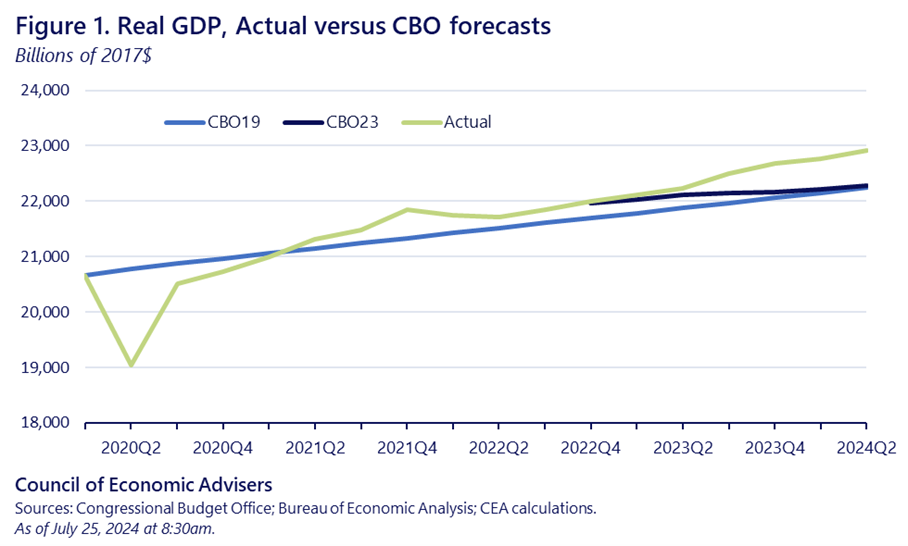The Big Beat: GDP Beats Expectations and Prior Forecasts
Real GDP beat expectations in the second quarter of the year, up 2.8%, powered by strong consumer spending, solid business investment, and a bounce back in inventory investment. For details of the strong report, see CEAs X thread.
In this post, we build on this above-expectations theme by showing how real GDP grew relative to earlier forecasts by the Congressional Budget Office. The figure shows actual GDP, including today’s print, alongside two CBO forecasts, one published in 2019 and the other published a year ago.
It’s not at all surprising that a 2019 forecast, even by the highly skilled CBO team, would miss the pandemic-induced recession, as their forecast was made before the pandemic took hold. So, think of that line as tracking how forecasters thought trend GDP growth would unfold in the coming years, barring any shocks. Actual GDP, however, has done considerably better than that, tracking above CBO’s 2019 forecast since mid-2021, despite the large downturn in 2020.
Of course, by 2023, the economic impact of the virus was well-known, as seen in the CBO’s forecast made that year. By 2023, the more recent CBO forecast underestimated where growth was headed. This is visible by the separation of the vintage ’23 forecast and the actual series up through the newest data point released this morning.

To be clear, this is not a critique of CBO’s long and careful forecasting record. Many forecasts follow this same pattern; it wasn’t that long ago that news outlets were clamoring that a recession was near-inevitable.
In prior posts, CEA has discussed in some detail the factors that have helped generate this over-performance. Briefly summarizing here, we know that our persistently strong job market has been generating solid wage gains that have been consistently beating inflation, which itself has eased significantly. In this last quarter, for example, consumer spending added 1.6 percentage points to the 2.8% growth rate. The Biden-Harris Administration’s investment agenda has also helped support growth in key areas of present and future growth, including semiconductors and clean energy production.
Of course, we have more work to do. Maintaining the strong job market helps boost workers’ bargaining clout, supporting real wage gains. Continuing to execute our investment agenda is equally essential to build out the new, domestic industries and factories coming online. Even with much lower inflation, many prices are still too high, making President Biden’s cost-cutting agenda as important as ever. But the strong GDP growth we saw in this and previous quarters is a powerful sign that we remain solidly on the right track.
